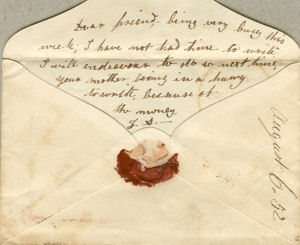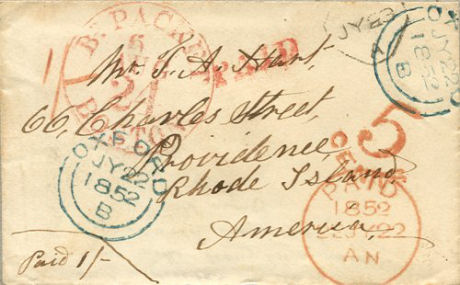![]()
Postal History Introduction
Stampless
Covers
1846
to 1900 Issues
1901-1950
Issues
1951-2003
Issues
Cancels
&
Miscellaneous
Postal
Stationery
Post
Cards
Air
Mail
First
Day &
Event Covers
Parcel Post/Special Delivery
Registered & Official Mail
Commercial & Advertising
Revenue & Postage Due
Wildlife & Game Issues
Complete List of RI Issues
|
Rhode Island Stampless
Covers & Letters |
|
|
Reverse with
message written on inner flap (Text
reproduced below)

| This is a very busy cover with several interesting markings; all on the
face of the envelope. The envelope itself is a small
"Woman's" envelope measuring only
105 x 65 Millimeters,
(41/8
x 21/2 inches).
There was no
letter with the cover, just the message on the inside of the flap. It
was docketed on the reverse with
August 6, 52 when received in Providence,
RI.
The "Pre-Paid" letter was mailed on July 22, 1852 from Oxford, Oxfordshire, England as indicated by the blue Oxford CDS's. It was routed through London where it received the red Paid July 22 CDS, (lower right-hand corner). The cover was then routed from London to Liverpool where it received the L JY 23 A marking in black. The Royal Mail Packet; Cunard Steamship, "Niagara" departed Liverpool on July 24, 1852 and arrived in Boston on August 5th, where the letter received the "Br. Packet 5 Aug 24 (cents) Boston,", the straight line "PAID" and "5 Cents" markings. There is also a script "Paid 1 Shilling" at bottom left of the cover, which was applied at the point of origin.
|
||
| 12
Pence English = 1 Shilling 20 Shillings = 1 Pound 240 Pence = 1 Pound |
1
Pound = $4.90 American 1 Shilling = 241/2 cents American |
|
| Thus, the pre-paid
1 Shilling
at the point of origin
equals the
24
cents shown in the Boston Br. Packet marking. This breaks down as
follows: 3 cents - British Inland Rate,
16 cents - Sea Postage and
5 cents - United States Inland Postage.
Cunard liners and the Niagara The Niagara was constructed by Robert Steele and Company in 1847. She was propelled by Side Lever Paddlewheels with a gross tonnage of 1834 grt. She was 251 feet in length overall with a beam of 38 feet. She entered service in 1848, departing on her maiden voyage from Liverpool on May 20, 1848. In 1854, Great Britain became embroiled in the Crimean War with Russia and began commandeering Cunard Steam Ships for use as troop carriers. The Niagara was commandeered in November 1854 and was out of service through most of 1855; returning to to the Atlantic mail service on May 24, 1856 and arriving in Boston on June 6th. In 1862 Cunard added two new Steamships, the Scotia and China to his fleet. Niagara made her final trans-Atlantic crossing from May 3 to June 8, 1862. She was sold to Duncan Dunbar in 1866 and converted to sail. NOTES: SEE ALSO:
Thomas Hunt Oxford, Oxfordshire, England The message on the inside of the flap reads
as follows: Sources and
Suggested Additional Reading: |
||

RI Historical
Society
Introduction
Stampless I
Stampless II
Stampless III
Stampless IV
Stampless V
Stampless VI
Brown & Ives Letters
The Hazard Family Letters
Joseph Tillinghast
Free Franked Letters
DeWolf Family Letters
Recently Added Pages
